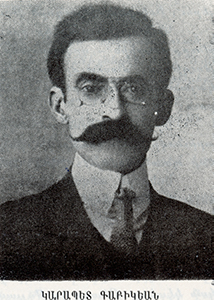24.02.2021

I am the source of my history as an eyewitness until the very end.
I took notes concerning events in Sebastia (Sivas) every day and,
although I later destroyed them all, they all stayed in my mind.
Each survivor has his “story.” I have selected many people’s accounts.
Karapet Gabikyan
Karapet Gabikyan, a lexicographer and ethnographer, was a remarkable Western Armenian intellectual and community activist. He was born in the Western Armenian city of Sebastia (Sivas) in 1861. He received his education in the school in the city then took up pedagogical work. He wrote many articles and three large-scale works.
When the mass arrests of Armenian intellectuals began in the spring of 1915 and exile became inevitable, Gabikyan voluntarily destroyed his works, notes and literary creations. Having been deported from the city with his family, he lost all of them on the road to exile.
Miraculously having survived, he was exiled to Aleppo in 1919, where he spent the last decade of his life suffering the bitterness and torture of his deportation. He had begun to write his memoirs when he was in Rakka during his deportation.
He corresponded, during his years in Aleppo, with Armenian refugees from Sebastia (Sivas), collecting survivors’ stories and verifying Armenian place names in the region.
With a compatriot, Griqor Pahlevanyan, he founded the “Sebastia Armenians’ Compatriotic Society” which concerned itself with survivors’ statistics.
He wrote the book “The History of the Catastrophe of Armenia Minor and its Great Capital Sebastia” in 1920, which was the collective memoir of surviving Armenians from the region, collated by an intelligent researcher and very knowledgeable eyewitness. This book, based on fact, may be considered to be real testimony and research.
Although several versions of the manuscript of this book have been lost, Gabikyan was able to complete and have this very valuable work published.
The original version of the book, presenting the history of the deportation, was written in Rakka at the request of Sargis Manukyan, a clergyman and pedagogue.
Gabikyan wrote:
When I got to Rakka, I stayed in a separate room for about two months. It was at that time that I wrote this history of the deportation, at night, in a very brief style. I handed it over to Mr. Sargis Manukyan who, when he went to Aleppo, was to give it, with the report concerning the Karin (Erzerum) deportation, to the German consul there. He took it with him, but being threatened by a relative, burnt it.
Gabikyan started the second version of his book after he arrived in Aleppo, where he’d become acquainted with Aram Antonyan; he collaborated with Antonyan in the preparation of the latter’s transcription and collation of survivors’ memoirs. He handed Antonyan the second version of the manuscript of his book “The History of the Catastrophe of Armenia Minor and its Great Capital Sebastia,” who approved of it felt it was worth publication.
Karapet Gabikyan, accepting the Armenian Patriarchate of Jerusalem’s invitation, moved there, taking 11 Armenian orphans with him. He settled in Jerusalem, working in Armenian schools as an Armenian language, history and geography teacher. It was in those years that he completed the definitive version of his “history,” sending it to the journal Yeritasard Hayastan in Chicago, USA, for publication.
“The History of the Catastrophe of Armenia Minor and its Great Capital Sebastia” was published in Boston, USA, the author using the nom-de-plume “Guzhkan Sebastio”.
Gabikyan’s great tome book begins with the Balkan War and the political situation in the Ottoman Empire at the time. Using proof, he demonstrates that the physical destruction of the Armenians of Sebastia (Sivas) had been planned for a long time. Just as in other deported contemporary Western Armenian intellectuals’ works, here too are horrifying descriptions of scenes and massacres taking place on the road to exile.
He presents the history of the deportation of the 350,000 Armenians of historic Western Armenia and Armenia Minor, among which were 5,800 households of Armenians from Sebastia (Sivas) or between 34,000 and 36,000 individuals.
He gives precise details concerning Armenian villages close to Sebastia (Sivas) that were demolished and razed to the ground.
Providing accurate details of the road to exile, he inserts certain memoirs concerning specific Armenians from Sebastia (Sivas). He also reflects on the state of the Armenian deportees, the aid being provided, the work of collecting orphans, as well as the release of Armenian women that had been held in harems and forcibly converted to Islam.
Gabikyan was one of the first people to point out the role played by the Germans in the question of the deportation and massacres of Armenians, considering them to be the Turks’ instructors.
In his work he gives considerable space to the deportees’ main encampments: Ferenchlar, Suruj and Rakka.
Gabikyan was very distressed at the destruction of the Armenian people’s spiritual and cultural values; in Chapter 48, titled “Sebastia after the forced deportation,” the author recalls every one of the destroyed monasteries and churches so loved by the Armenians of the city.
He married Azniv, the daughter of the well-known Norarevyan family from Sebastia (Sivas) in Aleppo in 1919. They had two children.
Karapet Gabikyan died in Jerusalem in 1925.
Kristine Najarian
Head of the Department of Educational Programs
_________________________________
1. Գուժակն Սեբաստիոյ,
«Եղեռնապատում Փոքուն հայոց և նորին մեծի մայրաքաղաքին Սեբաստիոյ», Պոսթըն, 1924:
2. Պատմագիրք Յուշամատեան Սեբաստիոյ եւ գավառի հայութեան, հատոր Ա, Պէյրութ, 1974:
3. История уничтожения Малой Армении и ее великой столицы Себастии, Ереван, 2015.





